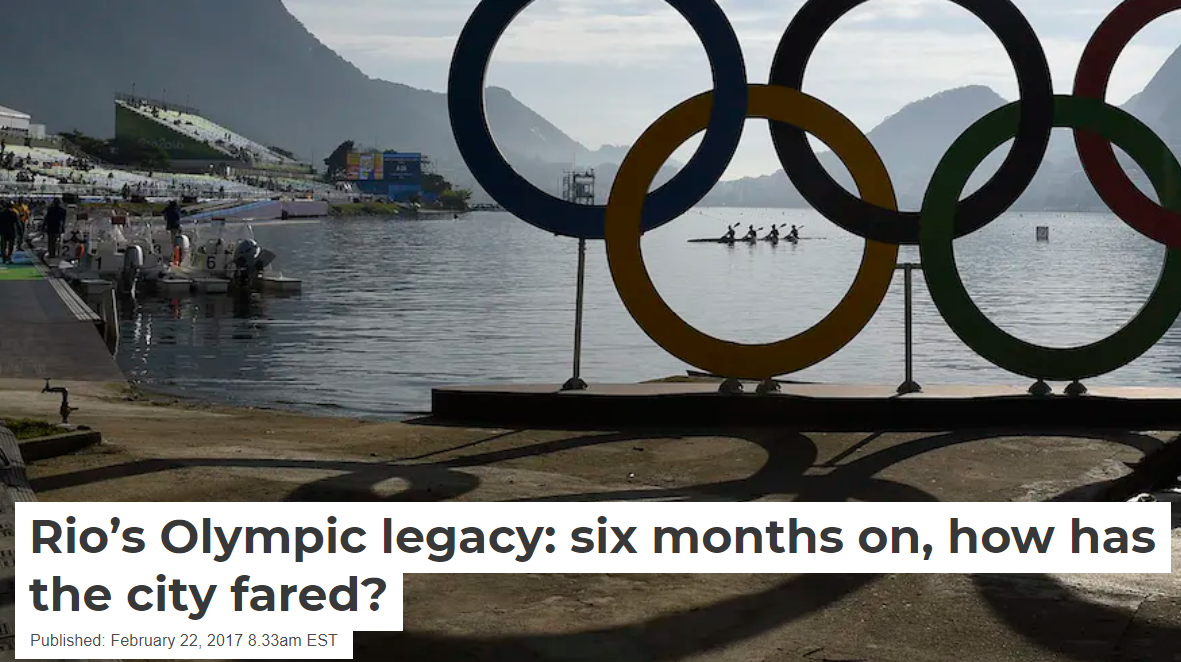Thought piece: "Rio’s Olympic legacy: six months on, how has the city fared?" (Duignan and Ivanescu)
Originally published in ‘The Conversation’, available here: Rio's Olympic legacy: six months on, how has the city fared? (theconversation.com)
It’s been over six months since the Olympic games came to a close in Rio. With the benefit of hindsight, many are surveying the city with a critical eye, wondering whether the multi-billion dollar mega-event was “worth it”.
When a city is graced by the pinnacle of cultural and sporting celebration that is the Olympic Games, it also carries out a programme of ambitious urban development: from short-term regeneration to longer-term infrastructure works. Since the start of the century, such non-sporting outcomes have become a major part of the bidding process for would-be host cities.
Today, a bid to host the Olympics can provide a powerful political will for change, pool public and private money together in enormous funds, and catalyse urban development at an astounding rate.
Mixed visions
Yet event-led policies are complex. They cut across many different locations, affecting communities and businesses in myriad ways. Competing interests must be prioritised, and those with money and power are often better able to influence outcomes to their advantage than poorer, less “visible” residents.
Don’t let yourself be misled. Understand issues with help from experts
Get the newsletter
Rio’s favelas offer a case in point. Around 23% to 24% of the city’s population live in informal or slum housing, and many were hit with forced evictions to make way for sports facilities or transport routes. One civil society group calculated that 22,059 families were evicted across the city ahead of mega-events between 2009 and 2015 – that’s approximately 77,206 people.
Here we find that mega-events escape from the confines of democratic planning, and avoid the progressive, plural and consultative processes typically found as part of the “normal” governance of daily life. Scholars have observed that during the planning and delivery periods, host cities symbolise “Olympic states of exception”, wherein urban policies are fast-tracked to deliver the infrastructure in time for the games.
The vision for Rio’s Olympic legacy drew a mixed response before the games even began, so now that they’re over, the city is in for some heavy scrutiny. To even the most optimistic eye, it’s clear that in places, reality falls far short of the dream.
Venues remain without owners, part-functioning or in complete disarray. They are transforming into text-book examples of “white elephants”; flashy developments built for show, which fall out of use and become a burden on public funds once the party is over. For the residents of a city which was already struggling in the grips of economic, political and health crises, this must be especially frustrating.
A ray of hope
But while the physical remnants of the games are withering, the cultural legacy of Rio’s Porto Maravilha shines bright. Before being made-over for the games, the area had a reputation for being unsafe: abandoned buildings were blemished by broken windows, and locals avoided walking there after dark.
But now, six months on, it’s the place to be: throngs of people can be seen cycling or strutting across what was the largest ever “live site” in Olympic history. The Porto Maravilha has become a cultural hub, where locals and visitors gather to eat local street food and soak up the sights, which include attractions such as My Porto Maravilha and one of the world’s largest murals.
Of course, this kind of urban make-over can have unintended consequences. Gentrification occurs when major structural and economic changes force lower income communities out of an area, and it’s one of the biggest challenges faced by Olympic host cities, past and future.
In the case of the Barcelona 1992 games, it was found that gentrification “changed the social mix” of local communities and caused house prices to jump 250% between 1986 and the start of the games. Similarly, since the Olympic park was constructed for London 2012, the thriving community of artists in nearby Hackney Wick has been threatened with displacement.
Regeneration is a two-sided coin: it can raise the standards of living for local residents – or progressively drive them out entirely. The risk is that every time Olympic developments price out locals by driving up housing costs, it makes the prospect of hosting the Olympics a little less attractive.
The truth is, much of the story of Rio’s Olympic legacy has yet to be written. And what counts as a win to some may feel like a sore loss to others. There will be businesses that continue to ride the wave of trade after the event, while creatives capitalise on the port’s new cultural scene. But there will also be poorer, more vulnerable residents struggling to find and settle into new homes. Perhaps the best way to judge is to visit and see for yourself.
